Vehicle-to-grid car generates electricity and cash for owners
Vehicle-to-grid car generates electricity and cash for owners
University of Delaware
December 4, 2007
University of Delaware researchers have created a system that enables vehicles to not only run on electricity alone, but also to generate revenue by storing and providing electricity for utilities. The technology–known as V2G, for vehicle-to-grid–lets electricity flow from the car’s battery to power lines and back.
The price of oil nearly reached $100 a barrel recently, but a new University of Delaware prototype vehicle demonstrates how the cost of the black stuff could become a concern of the past.
A team of UD faculty has created a system that enables vehicles to not only run on electricity alone, but also to generate revenue by storing and providing electricity for utilities. The technology–known as V2G, for vehicle-to-grid–lets electricity flow from the car’s battery to power lines and back.
“When I get home, I’ll charge up and then switch into V2G mode,” said Willett Kempton, UD associate professor of marine policy and a V2G pioneer who began developing the technology more than a decade ago and who is now testing the new prototype vehicle. The UD V2G team includes Kempton as well as Ajay Prasad, professor of mechanical engineering; Suresh Advani, George W. Laird Professor of Mechanical Engineering; and Meryl Gardner, associate professor of business administration, along with several students.
 Under the hood of a University of Delaware prototype car with vehicle-to-grid technology (photo by Willett Kempton/University of Delaware). Honda sees no future for plug-in hybrid vehicles
Ford Motor to introduce plug-in hybrids, but lags behind rivals
Measures to drive adoption of super efficient cars in the U.S.
U.S. can cut oil imports to zero by 2040, use to zero by 2050
Plug-in cars could help fuel Austin power grid |
When the car is in the V2G setting, the battery’s charge goes up or down depending on the needs of the grid operator, which sometimes must store surplus power and other times requires extra power to respond to surges in usage. The ability of the V2G car’s battery to act like a sponge provides a solution for utilities, which pay millions to generating stations that help balance the grid. Kempton estimates the value for utilities could be up to $4,000 a year for the service, part of which could be paid to drivers.
The technology will work on a large scale, he said, because on average 95 percent of all cars are parked at any given time. One hour a day of car usage is the average in America.
“A car sitting there with a tank of gasoline in it, that’s useless,” he said. “If it’s a battery storing a lot of electricity and a big plug that allows moving power back and forth quickly, then it’s valuable.”
Kempton already has one of those large plugs at his home. He has a 240-volt plug that gives the battery a full charge–or a range up to 150 highway miles–in just two hours. A smaller, standard 110-volt plug works but provides a full charge in about 12 hours. The smaller plug also moves less power for the grid operator when the car is in V2G mode, Kempton explained.
“The bigger the plug, the more power you can move, the more revenue,” he said, explaining that it cost about $600 to have the larger plug installed.
But even though Kempton is supplying power to the grid with the prototype car, he’s not getting paid for it–yet.
PJM, the grid operator for 14 states, including Delaware, is keen on the technology and hosted a demonstration of the V2G car. But PJM requires at least 300 megawatts to purchase power. That means the UD team and its collaborators must get 300 cars up and running.
The prototype car is a stepping-stone to that goal. Kempton is working with UD mechanical engineers Prasad and Advani, who plan to add V2G to the University’s hydrogen fuel cell bus. Next, the team, including the company that created the car, California-based AC Propulsion, will test the prototypes and fix any potential problems they bring to light. Then they’ll begin creating a user interface that will let drivers, for example, tell the car to never go below 50 percent charge while in V2G mode.
Helping him to learn what types of features potential buyers would want on the car and to identify potential buyers are business administration faculty member Gardner and her students. They’ve done a pilot survey of nearly 100 drivers that’s shown there’s a lot of interest in the technology, she said.
“We also want to provide information on how to market the car,” she said, so her team is asking people questions like how much they would be willing to pay for it and how they feel about driving a car that’s better for the environment than a gasoline-powered vehicle.
That last question gets Kempton, who also is involved in College of Marine and Earth Studies research on offshore wind farms, the most excited. He explained that even if the electricity used to charge the car is produced by a coal-fired power plant, the car itself produces no carbon dioxide emissions. If a wind farm fuels the electricity from the power plant, he explained, the car and its power source would be emissions free.
And even though the green aspect of the car is key for Kempton, he knows consumers might have some other, more practical, questions about the vehicle, such as, “What’s it like to drive?”
Zippy yet quiet, being behind its wheel is a thrill, he said. “I hate getting back in my gas car. It feels sluggish.”